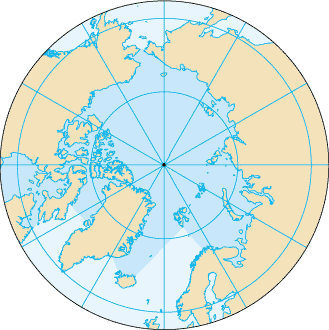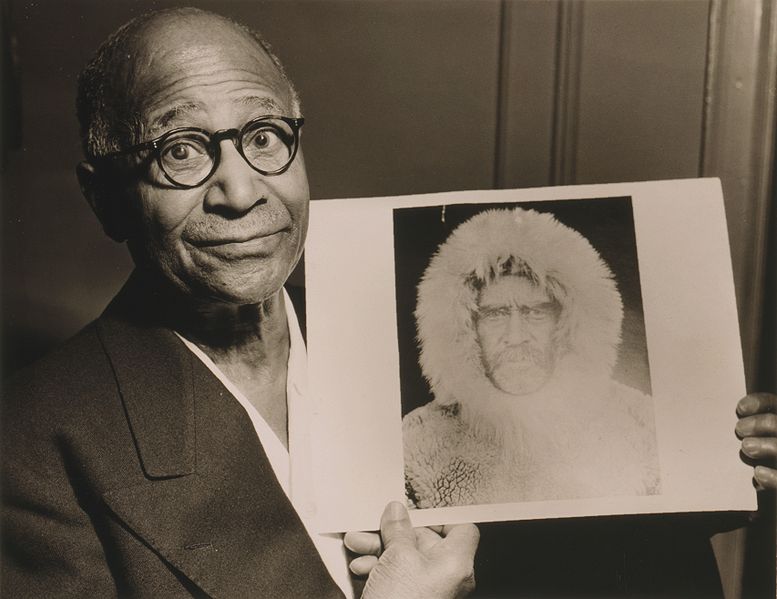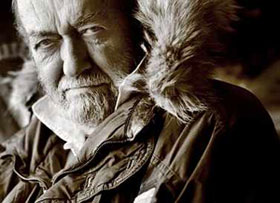“Antarctic history is peopled by true heroes: Amundsen, Shackleton, and the tragic Robert Falcon Scott, who experienced one of the greatest disappointments in the annals of exploration when he reached the South Pole in 1912 to find the Norwegian flag flying there. The race to the High Arctic, by contrast, is tainted with friction, argument, and accusations of barefaced lying. That many cannot name the explorer who first stood on the world’s northern extremity is because the dispute over who it was has never been settled” (source).
Unlike the South Pole, the North Pole is located in the middle of an ocean (the Arctic Ocean, also known as Polynia or the Open Polar Sea) whose waters are almost permanently covered with constantly shifting sea ice. Early attempts to reach the North Pole in the 19th century all failed. British naval officer William Edward Parry was forced to turn back in 1827, as was the American Charles Hall in 1871. In 1895, Norwegian explorers Fridtjof Nansen and Fredrik Hjalmar Johansen got to 86 degrees 14’ north before being forced back, and an expedition led by the Italian Luigi Amedeo made it to 86 degrees and 34’ in 1899 before admitting defeat.
Just after the turn of the century, however, two arctic explorers claimed to have reached the North Pole. The American explorer Frederick Albert Cook claimed to have reached it on April 21, 1908, with two Inuit men, Ahwelah and Etukishook, but he was unable to produce convincing proof and his claim is not widely accepted. Accordingly, “the conquest of the North Pole was for many years credited to US Navy engineer Robert Peary, who claimed to have reached the Pole on April 6, 1909, accompanied by Matthew Henson and four Inuit men named Ootah, Seeglo, Egingwah, and Ooqueah. However, Peary’s claim remains controversial. The party that accompanied Peary on the final stage of the journey included no one who was trained in navigation and could independently confirm his own navigational work, which some claim to have been particularly sloppy as he approached the Pole. The distances and speeds that Peary claimed to have achieved once the last support party turned back seem incredible to many people, almost three times that which he had accomplished up to that point. Peary’s account of a journey to the Pole and back while traveling along the direct line – the only strategy that is consistent with the time constraints that he was facing – is contradicted by Henson’s account of tortuous detours to avoid pressure ridges and open leads” (source).
And who was Matthew Henson? “Robert Peary’s hunger for the Pole, and for fame, was insatiable. He made 7 grueling Arctic expeditions between 1886 and 1909. The only man who accompanied him on each of those expeditions was Matthew Henson. Together they faced the harshest of Arctic challenges and together they planted the American flag at [what they thought or claimed was] the Pole. But Peary, who author Fergus Fleming called ‘the most unpleasant man in the annals of polar exploration,’ had no interest in sharing the glory of the accomplishment with any other man, especially a black man. Years before his quest for the Pole commenced, Peary had written to his mother, ‘I must be the peer or superior of those about me to be comfortable.’
And Henson made Peary very uncomfortable indeed. While Peary viewed him as an inferior, it was Henson who was essentially the de facto leader of the Polar expeditions – Henson who took care of the other men, dogs, and supplies; Henson who spoke the Eskimo language; Henson who fixed the sledges (tough sleds) and used those sledges to pull Peary, who’s [sic] walking ability was hampered by the loss of 8 of his toes to frostbite on a previous expedition, to and from the Pole. …Peary had secretly planned to leave Henson behind once they got close to the Pole, so that he could claim farthest north all for himself. But the expedition made better time than he realized (it’s hard to keep track when you’re lying in a sled), and the team landed at [what Peary claimed or thought was] the Pole before he had a chance to ditch the others…Crestfallen that he had to share the glory of the moment with 4 Eskimos and a black man, Peary immediately ceased to speak to Henson, the man who had saved his life on a previous expedition and had remained absolutely loyal to him for 22 years when every other member of the expeditions had left because of Peary’s insufferable personality and demands” (source).
Henson actually arrived at what they thought was the Pole ahead of Peary, and, when Peary caught up, Henson reputedly greeted him by saying “I think I’m the first man to sit on top of the world.” “Henson later recalled that this angered Peary: ‘Oh, he got hopping mad … No, he didn’t say anything, but I could tell,’ wrote Henson. Henson wrote that Peary ‘fastened the flag to a staff and planted it firmly on top of his igloo’” (source). Predictably, Peary took all the credit for supposedly being the first man at the North Pole, and he was given a Rear Admiral’s pension and the Thanks of Congress by a special act of March 30, 1911. Henson’s role went unrecognized for years, and he went on to live in virtual obscurity, earning a living as a customs clerk in New York and giving occasional lectures about his experiences. In 1947, he published his story, A Negro at the North Pole (with a foreword by Booker T. Washington), and, toward the end of his life in 1955, he received many awards, including ones from Presidents Truman and Eisenhower, in belated acknowledgement of his arctic achievements. On 6 April 1988, his body was moved from Woodlawn Cemetery in New York and, ironically, re-interred next to Peary’s tomb at Arlington National Cemetery in Washington, D. C.
Article by Bill Norrington






